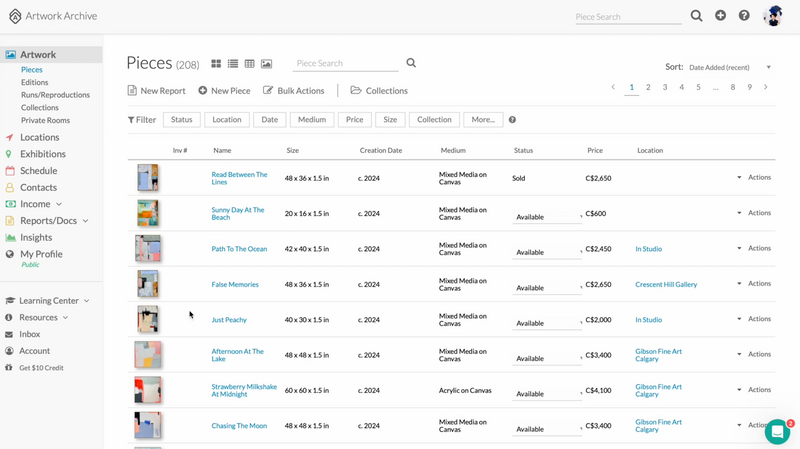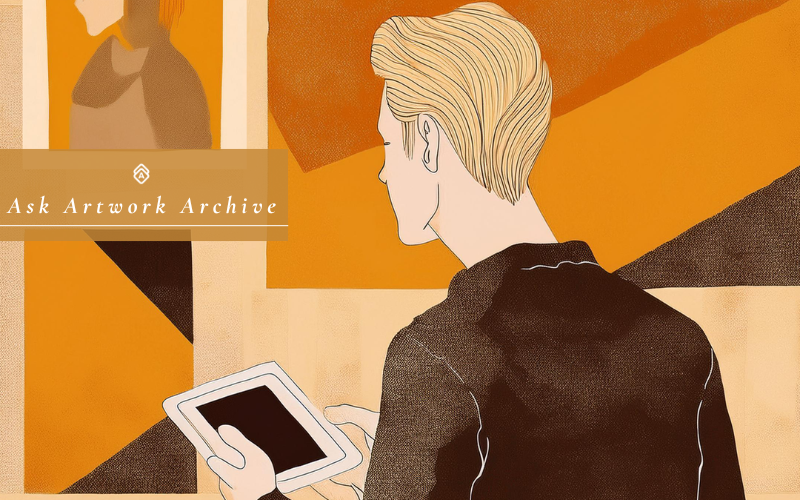Welcome to Ask Artwork Archive, your go-to space for the art career questions no one else seems to want to talk about.
Ask Artwork Archive is where we dive into all the "I didn't think it would be this hard" moments of running an art business—like the ones that make you wonder if everyone else has it figured out but you. If you’ve ever felt like you’re navigating your art career in the dark, you’re in the right place.
This week, we’re unpacking a struggle that hits home for a lot of artists: when your studio is packed with work you’re proud of, your Instagram posts are getting engagement, but the sales? They’re just… not there.
How do you turn the art sitting in your studio into pieces collectors can’t wait to take home? Where do you start when it feels like no one is finding—or buying—your work?
Keep reading as we explore how to identify your ideal audience, build authentic relationships with buyers, and find new ways to breathe life into older work.
Dear Artwork Archive,
I'm an independent artist trying to build a sustainable art business, but I’m just not making sales. Even though I’ve created a large body of work, I’m struggling to connect with the right audience and turn them into paying customers—especially through social media. It’s been tough to figure out how to reach people who really resonate with what I create, especially since my work falls into a niche market.
I spend so much time crafting the perfect Instagram posts and sharing behind-the-scenes stories, and while they get a good amount of engagement and likes, they rarely lead to sales.
I feel like I’m shouting into the void when I try to promote my art to new audiences.
On top of that, I have a growing storage problem with unsold pieces. Right now, my studio is crammed with paintings I love, but I don’t know how to market older work in a way that feels fresh and exciting.
I know I need to get organized, create an inventory, and come up with a plan to sell these pieces while also moving forward with my business.
What strategies can I use to better understand my audience, build lasting relationships with customers, and make progress in selling both my current and past work? I’d love any advice you can share to help me tackle these challenges and grow my art business.
Thank you so much for your help!
Signed,
Collector-less and Confused
Dear Collector-less and Confused,
First off, let us say—you’re not alone. So many artists face the same struggles when it comes to finding the right audience and turning followers into buyers. It’s not easy, but you’re asking the right questions, and that’s a great start.
Let’s start with your audience. Who connects with the colors, themes, or stories you’re telling? Who feels something when they look at your work? Think about your ideal buyer and where they might be—on social media, at art markets, or within specific communities. If your art speaks to a niche audience, lean into that uniqueness. Seek out groups, forums, or events that align with your themes, whether online or in your local community (or both).
Here’s something to keep in mind though: while you’re asking yourself these questions, don’t lose sight of what you love to create. It’s easy to fall into the trap of thinking, What do people want to buy? and letting that guide your work. But chasing sales like that doesn’t lead anywhere good. It’s not sustainable, and it’s certainly not fulfilling. Instead, let your work guide you. Your authentic voice is what will resonate with the people meant to collect your art.
This is where a little organization can help. Even if you’re not making consistent sales yet, creating an inventory gives you clarity and helps you spot patterns (ahem, we might have built a tool just for that). Over time, this can reveal who’s naturally drawn to your work, making it easier to reach out to the right people who already love your art for what it is.
Your ideal target audience is out there; they just might not know you exist yet. That’s where your intentional outreach comes into play. It sounds like you’re active on social media, which is a fantastic tool to help your audience discover you, but it’s worth taking a closer look at who’s currently engaging with your content.
Take a look at who’s following you. If the majority are fellow artists, that might explain why you’re seeing engagement (likes, comments, follows) but not many sales. Artists are amazing for support and community, but if you want to sell, you need to start reaching buyers.
So how do you do that? Start by shifting what you share. Post more content that speaks directly to buyers—like photos of your art styled in real spaces or testimonials from happy collectors. Talk about how your work fits into someone’s life, not just your process. Even small steps, like including “This piece is available—DM me for details!” in your captions, can open the door for conversations with buyers. Also, spend time engaging with the kind of people who are likely to buy your art. Follow interior designers, art enthusiasts, or local businesses that align with your style. Comment on posts and join conversations where your ideal buyers are hanging out.
But, don’t let those connections stay online only—bring them into the real world. Keep track of collectors and potential buyers using Artwork Archive’s Contact Management tool, so you know exactly who to reach out to. Maybe you send them an email about a new piece you think they’d love or invite them to check out your work at a pop-up or studio visit. Your goal is to build real relationships with people who love your work. Over time, that network will grow and create even more opportunities to share your art with the right people.
Now, about that unsold work filling up your studio space—we get it. It can start to feel suffocating and honestly, it might even be blocking your creativity. Start by creating an inventory of everything you have. If you’re using Artwork Archive, this part gets so much easier. Once everything’s logged, you’ll have a clear picture of what’s in your studio and what’s ready to market. And remember, over time you’ll also start to see trends and patterns, like which types of pieces are selling best.
If space is tight, pack up older work and move it to storage. With every location tracked in Artwork Archive, you’ll always know exactly where those pieces are. Having that system in place makes it easier to part with them physically, and it clears up space for your next creative ideas.
And don’t give up on those older pieces. Share them in a new way—tell the story behind the work, pair it with styled photos, or offer perks like discounts for first-time buyers or free shipping. Sometimes all it takes is a little reframing to spark interest.
Take things one step at a time. You don’t have to shout louder than everyone else—just create the space for the right people to lean in closer. Keep the door open long enough for them to walk through.
Trust your work. Trust yourself. The audience you’re looking for is out there, and your art is what they’ve been waiting for.
—Artwork Archive
Your Studio, at a Glance:
Feeling overwhelmed by unsold pieces taking over your space?
With Artwork Archive’s inventory tool, you can see exactly what’s in your studio, track where it’s been, and make better decisions about how to market it. Free up your mental (and physical) space by creating a system that keeps you focused on moving forward.

A platform view of artist Paige Ring's main Artwork Archive Pieces Page. Photo courtesy of the artist
Have a sticky situation in your art business you're trying to navigate?
Whether you're wrestling with pricing questions, client communications, gallery relationships, or those delicate professional boundaries—we know running an art business comes with unique challenges.
Have a situation in your art career keeping you up at night? A professional puzzle you'd love help solving? Share your question through the form below. You could get the guidance you're seeking, and your experience might just help fellow artists navigate similar waters!
We're all in this creative journey together, and some of the best solutions come from our shared experiences.
We look forward to hearing from you!







